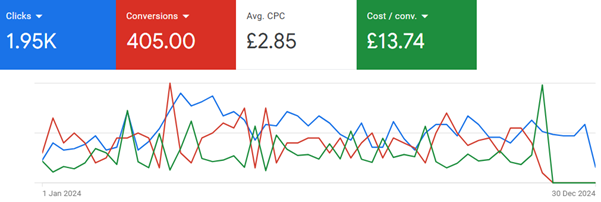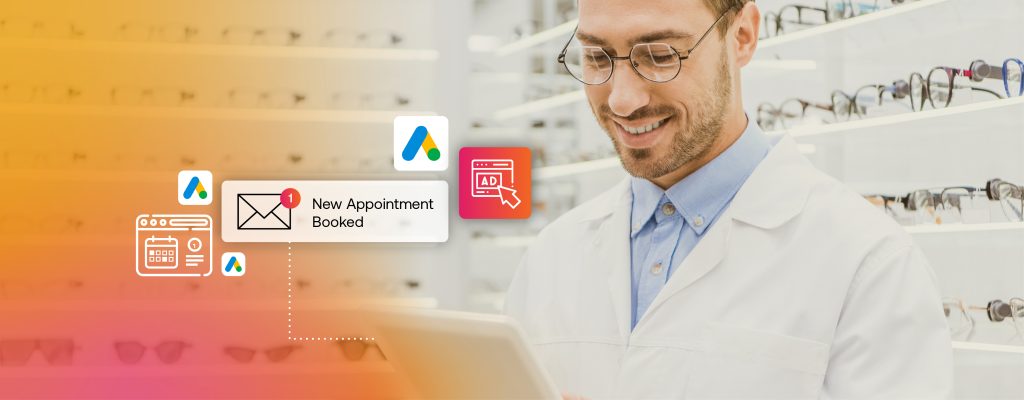Introduction
If you are curious about Google Ads for opticians, you are in the right place. With an ever-growing number of people searching online for eye care services, understanding how paid digital marketing works is essential. In this no-nonsense guide we will walk you through why paid ads for opticians can be a smart move, what is involved with optician PPC, and how digital advertising for eyecare can bring measurable results for your practice.
Why Google Ads Make Sense for Opticians
You appear when customers are actively searching
One of the strongest advantages of Google Ads is that your ad appears precisely when someone types in a relevant query. That means someone looking up “optician near me” or “eye test [Location]” could find your service at exactly the right time. This kind of intent-based exposure is far more effective than hoping someone happens to see an organic social media post.
You are always in control of budget and targeting
With Google Ads, you decide exactly how much to spend, where your ad appears, and when. You can focus on your catchment area and tailor messaging to appeal to people seeking eye tests, glasses or contact lens fittings. There is no big risk of overspending because you can pause, adjust or stop your campaigns instantly.
You can measure what matters
Unlike more traditional advertising methods, Google Ads provides real-time reporting. You can see clicks, conversions, cost per appointment and much more. That transparency means you can invest with confidence because you know exactly what return you are getting.
💡Discover Your Potential ROI with Google Ads
Curious what kind of return your practice could achieve? Use OptiCommerce’s free, interactive Google Ads ROI Calculator to estimate how much additional revenue Google Ads for opticians could generate for your business. Built specifically for independent eyecare practices by OptiCommerce.
Proof That Google Ads for Opticians Deliver Measurable Growth
One of our independent clients in England came to OptiCommerce seeking more patient bookings and a stronger online presence. Competing with major optical chains like Vision Express, Boots, and Specsavers, this single-location practice offered eye exams, glasses, sunglasses, contact lenses, and children’s eyewear but struggled to attract new patients online.
We began by enrolling the client in our entry-level marketing package, which included Google Ads for opticians, social media management, and blog content creation. Within the first year, OptiCommerce built a dedicated, mobile-friendly, high-performance landing page designed to convert visitors into patients. Detailed tracking tools, including call tracking, were implemented to monitor engagement and optimise campaign performance.
Over a 12-month period (January to December 2024), the campaign generated 405 patient enquiries, an average of 34 new leads each month. Each patient lead cost just £13.74 in Google click fees, making this one of the most cost-effective marketing channels for the practice.
Assuming an average dispense value of £250 and a 60% conversion rate, the practice generated approximately £5,120 in monthly revenue and around £1,800 in monthly profit after Google and marketing fees. The estimated customer lifetime value from these new patients was £25,600 per month, demonstrating how well-targeted Google Ads for opticians can drive sustainable growth.
Some of the best-performing keywords included “opticians near me,” “eye test near me,” and “opticians [location].”

Google Ads performance dashboard showing yearly results for an OptiCommerce client campaign
Key Stats You Should Know
Let’s look at three compelling statistics that illustrate why digital advertising for eyecare and specifically Google Ads for opticians, can be highly effective:
- 65% of smartphone users contact a business within 24 hours of a local search, underscoring the urgency of appearing in search results via Google Ads, according to Google’s Consumer Barometer.
- Businesses earn around £2 in revenue for every £1 spent on Google Ads, based on the Google Economic Impact Report for the UK (2019), illustrating how well-managed campaigns can pay for themselves and more.
- Half of local mobile searches lead to a store visit within a day, showing that search ads drive real footfall, not just clicks, per Google’s research on local search behaviour.
How to Set Up Google Ads for Your Optical Practice
Step 1: Define your campaign goal
Start with clarity. Do you want to drive eye-test bookings, sell frames or raise awareness of a new service? Your goal will determine how you set up your ads, the keywords you bid on, and where your budget goes.
Step 2: Choose the right keywords
Focus on the phrases your patients actually search, such as, “optician near me”, “eye test [location],” or “contact lenses optician”. Avoid marketing jargon. Use Google’s Keyword Planner to estimate search volumes and costs.
Step 3: Craft engaging ad copy
Write concise, benefit-focused ads. For example:
- “Need an eye test this week? Book now with Friendly Opticians. Same-day appointments available.”
- “Looking for stylish glasses? Visit our optical showroom today.”
Always include a clear call-toaction (CTA) such as “Book Now”, “Call Today” or “Find Out More”.
- CTA suggestion: “Ready to fill your appointment book? [Book Your Eye Test Today]”
Step 4: Set your budget and bid strategy
You can set a daily budget, for example £20 a day, and choose how much you are willing to pay per click. Start conservatively, monitor performance, and adjust your bids based on how well certain keywords convert.
Step 5: Monitor and optimise
Track key metrics such as:
- Click-through rate (CTR): Are people clicking your ad?
- Conversion rate: Are clicks turning into bookings or contact form submissions?
- Cost per acquisition (CPA): How much are you paying to gain a new patient?
Use this data to refine your campaign. If “eye test booking” keywords bring strong results, allocate more budget there. If another keyword underperforms, pause it to avoid wasted spend.
Common Concerns About Google Ads: Explained
“I do not have the time to manage ads”
Time is a fair constraint. Google Ads for opticians require regular attention. Many practices use agencies for support. At OptiCommerce we manage campaigns for clients so they can focus on their patients. Once set up properly, campaigns need only light weekly adjustments to keep delivering results.
“I am not sure it is worth the spend”
The statistics above show that Google Ads can deliver a healthy return on investment. You only pay when someone clicks, and if a fraction of those clicks turn into patients, your spend quickly pays off.
“Digital advertising sounds complicated”
Digital marketing does come with a learning curve. At its core though, Google Ads is about showing a relevant message to someone right when they need you. With proper guidance, most opticians see results within weeks.
“I do not have the time to manage ads”
Time is a fair constraint. Google Ads for opticians require regular attention. Many practices use agencies for support. At OptiCommerce we manage campaigns for clients so they can focus on their patients. Once set up properly, campaigns need only light weekly adjustments to keep delivering results.
“I am not sure it is worth the spend”
The statistics above show that Google Ads can deliver a healthy return on investment. You only pay when someone clicks, and if a fraction of those clicks turn into patients, your spend quickly pays off.
“Digital advertising sounds complicated”
Digital marketing does come with a learning curve. At its core though, Google Ads is about showing a relevant message to someone right when they need you. With proper guidance, most opticians see results within weeks.
Balance Benefits and Risks
Automation offers consistency, but overdoing risks alienating patients. Be mindful of:
- Frequency: sending too many emails can lead to unsubscribes; use your metrics to find a cadence that keeps patients engaged but not overwhelmed.
- Relevance: poorly segmented campaigns (for example, promoting contact lens solutions to frame only wearers) reduce trust.
- Compliance: ensure you have consent to send marketing emails and offer easy opt-out.
- Tone: avoid sounding like a bot; maintain a human voice and signoff.
Referring to our earlier article 7 Optician Marketing Mistakes That Cost You Patients, remember that generic communication and overuse of promotions are common pitfalls. Combining automation with a personal touch helps you avoid these missteps.
Best Practices at a Glance
| Practice | Why it Matters |
|---|---|
| Use location targeting | Ensures your ads reach people near your practice |
| Schedule ads around working hours | Reduces wasted spend when staff cannot take bookings |
| Use ad extensions (call buttons, map location) | Makes it easy for people to contact or find you |
| Include patient-focused messaging | Builds trust and relevance, for example “experienced friendly team” or “family-run” |
| Test, review and refine | Regular optimisation avoids wasted budget and improves performance |
When Google Ads Might Not Be the Right Move
If your practice is brand new and not yet ready for online bookings or phone calls, it may be wise to first ensure your website and scheduling systems are ready. A great ad is only as effective as the experience that follows when a patient clicks.
In some areas, search volume for optician terms may be low. In those cases, you can start with broader phrases such as “eye test” or “glasses shop” while building your visibility.
Final Thoughts
So, should opticians use Google Ads? The real answer is not simply yes or no. It depends on timing, goals and execution. What is clear is that when managed correctly, paid ads for opticians through optician PPC can be a powerful way to reach motivated patients, drive bookings, and maximise the return on your marketing spend.
By setting clear goals, writing persuasive ad copy, monitoring performance, and applying ongoing improvements, your practice can thrive in the competitive world of digital advertising for eyecare.
📣 Want help getting started? Contact OptiCommerce today for a free audit of your current digital presence, or speak to our team about how we can manage your Google Ads campaigns so you can focus on caring for patients.




